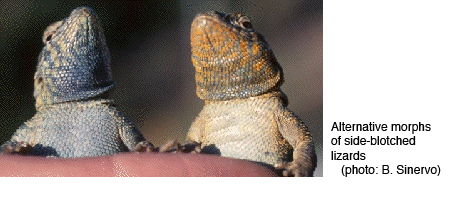- Research Overview
- Current Research
-
Previous Work
- Polyphenism Evolution: Phenotypic Plasticity and Locomotor Performance in Spadefoot Toads
- Life History Evolution: Costs of Reproduction, Offspring Size/Number Trade-Offs, and Locomotor Performance
- Morphological Scaling Relationship Evolution: Butterflies
- Ecological & Functional Morphology
- Development & Trait (Micro) Evolution

Ecological & Functional Morphology
Phenotypic variation causes variation in performance of many ecological tasks that affect fitness. Hence, natural selection acts on phenotypic variation through the effects of traits on performance in activities such as locomotion, courtship, or prey location, capture and handling. If the performance-affecting phenotypic variation is heritable, then selection will sculpt the phenotype indirectly by acting on the related variation in performance. The relationships between genotypic, phenotypic, performance, and fitness variation can be studied at a variety of levels to address questions central to understanding the evolution of life histories, complex life cycles, and complex phenotypes such as the scaling relationships among morphological traits or alternative, coupled morphological-behavioral reproductive types. My previous work on this topic, described below, focused on discrete forms of phenotypic variation, as described below. My current work takes a more fine-grained approach to study the relationships among continuous phenotypic variation, performance and fitness; details of this ongoing research are here.
Locomotor Performance and Polyphenism Evolution in Metamorphic Spadefoot Toads
Larvae of the spadefoot toads Scaphiopus multiplicatus and S. bombifrons are polyphenic. Under some conditions, typical omnivorous tadpoles develop alternative trophic and behavioral phenotypes, becoming rapid-developing carnivores that consume anostracan shrimp and other tadpoles. Although these tadpoles differ dramatically in morphology and behavior, the toadlets into which they metamorphosis are superficially indistinguishable. I studied the relationship between larval developmental history and several aspects of metamorph locomotor performance. In a series of experiments, I used environmental manipulations to alter the typical correlations between morph (omnivore/carnivore) expression, diet, and metamorph morphology. I found that larval morph interacts with several ecological factors, affecting maximal speed, the onset of fatigue, and endurance in a morphology-independent manner. Such post-metamorphic effects of larval phenotype on fitness enhance the benefits of condition-dependent larval morph expression in this system, and raises the interesting possibility that adaptations represented by the alternative larval phenotypes carry over to produce alternative, adaptively integrated, metamorphic trait suites.
Locomotor Performance and Costs of Reproduction in Side Blotched Lizards
Barry Sinervo, Don Miles and I used experimental manipulations to alter reproductive investment directly in females (follicle ablation and hormonal manipulations) and males (hormonal manipulation) of the side-blotched lizard, Uta stansburina. We then measured the effects of naturally occurring and experimentally-induced reproductive variation on locomotor performance and survival in the wild. In females, we found that reproductive investment was negatively related to endurance and survival. Experimental reduction of reproductive investment increased post-oviposition endurances, demonstrating that some performance cost is caused by the physiological toll of reproduction. Males in this population occur as three distinct phenotypes differing in appearance, behavior, and life history. Experimental elevation of testosterone levels in males raised the locomotor capacity of two phenotype classes to that of a third, territory holding/high-endurance/high-visibility phenotype. This increase was correlated with increased access to females and mortality. These studies reveal the mechanistic basis of tradeoffs that influence the evolution of reproductive investment in these lizards.
Relevant publications
Sinervo, B., D. Miles, D. DeNardo, W. A. Frankino, and M. Klukowski. 2000. Testosterone, endurance, and Darwinian fitness: Natural and sexual selection on the physiological bases of alternative male behaviors in side-blotched lizards. Hormones and Behavior 38: 222-233.
Miles, D., B. Sinervo, and W. A. Frankino. 2000. Reproductive burden of eggs decreases endurance and lowers survival in free ranging lizards. Evolution 54:1386-1395.